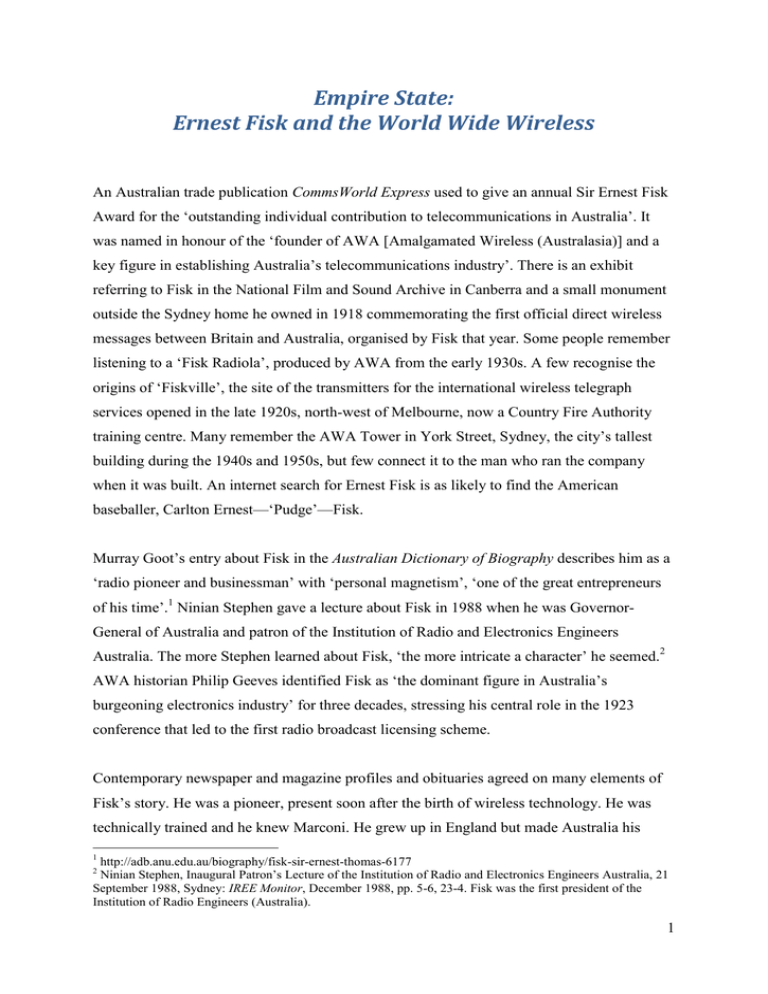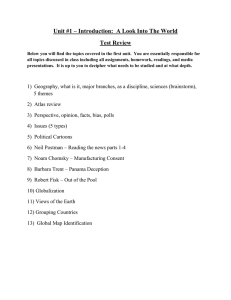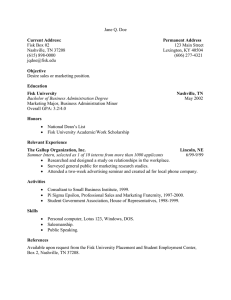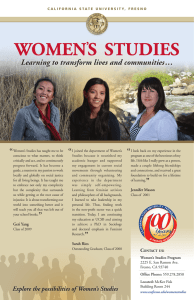Empire State: Ernest Fisk and the World Wide Wireless
advertisement

Empire State: Ernest Fisk and the World Wide Wireless An Australian trade publication CommsWorld Express used to give an annual Sir Ernest Fisk Award for the ‗outstanding individual contribution to telecommunications in Australia‘. It was named in honour of the ‗founder of AWA [Amalgamated Wireless (Australasia)] and a key figure in establishing Australia‘s telecommunications industry‘. There is an exhibit referring to Fisk in the National Film and Sound Archive in Canberra and a small monument outside the Sydney home he owned in 1918 commemorating the first official direct wireless messages between Britain and Australia, organised by Fisk that year. Some people remember listening to a ‗Fisk Radiola‘, produced by AWA from the early 1930s. A few recognise the origins of ‗Fiskville‘, the site of the transmitters for the international wireless telegraph services opened in the late 1920s, north-west of Melbourne, now a Country Fire Authority training centre. Many remember the AWA Tower in York Street, Sydney, the city‘s tallest building during the 1940s and 1950s, but few connect it to the man who ran the company when it was built. An internet search for Ernest Fisk is as likely to find the American baseballer, Carlton Ernest—‗Pudge‘—Fisk. Murray Goot‘s entry about Fisk in the Australian Dictionary of Biography describes him as a ‗radio pioneer and businessman‘ with ‗personal magnetism‘, ‗one of the great entrepreneurs of his time‘.1 Ninian Stephen gave a lecture about Fisk in 1988 when he was GovernorGeneral of Australia and patron of the Institution of Radio and Electronics Engineers Australia. The more Stephen learned about Fisk, ‗the more intricate a character‘ he seemed.2 AWA historian Philip Geeves identified Fisk as ‗the dominant figure in Australia‘s burgeoning electronics industry‘ for three decades, stressing his central role in the 1923 conference that led to the first radio broadcast licensing scheme. Contemporary newspaper and magazine profiles and obituaries agreed on many elements of Fisk‘s story. He was a pioneer, present soon after the birth of wireless technology. He was technically trained and he knew Marconi. He grew up in England but made Australia his 1 http://adb.anu.edu.au/biography/fisk-sir-ernest-thomas-6177 Ninian Stephen, Inaugural Patron‘s Lecture of the Institution of Radio and Electronics Engineers Australia, 21 September 1988, Sydney: IREE Monitor, December 1988, pp. 5-6, 23-4. Fisk was the first president of the Institution of Radio Engineers (Australia). 2 1 home. He was both a visionary who foresaw the future and a practical businessman who got things done. What he did was often presented as a long list of ‗firsts‘ and records. They were all about wireless, mostly involving the conquest of distance, especially the vast span between Fisk‘s birthplace and the place he spent most of his adult life—the first ship to use wireless in the Arctic, one of the first ships to use wireless on the England-Australia run, a record transmission from ship-to-ship, the first direct wireless messages between Britain and Australia, the first wireless telephony or broadcasting demonstration in Australia, the first direct wireless press messages between England and Australia, the first wireless telephone conversation between Britain and Australia, the first wireless picturegram between Britain and Australia and others. The agreed elements of Fisk‘s story could all be present in any one of these achievements. When a wireless telephone service was opened between Australia and Britain in 1930, it commercialised a connection first made by Fisk and Marconi in 1924. That first connection fulfilled a prophecy sooner than forecast. The wonders of wireless are innumerable, but surely this last passeth all understanding…With the consummation of Mr Fisk’s forecast in 1922 goes the last of the barriers that have sustained Australia’s notnecessarily-glorious isolation...What results to achieve in so short a period when we remember that the perfection of other inventions not a millionth the value of this have oftentimes demanded lives before giving up their tantalising, and, on occasions, more or less worthless secrets…Wireless witchery beggars all 3 description…There remains but to record. Will it ever end? Can it ever end? Pioneering was not just the beginning of Fisk‘s career, it was his career, an on-going program of imagination and action—speculating, experimenting, demonstrating, commercialising. This career required a program of story-telling. The firsts and records generally involved people besides Fisk, especially at AWA, so a good deal of his story is a personalisation of a corporate narrative. He was described as the ‗dynamic genius behind one of Australia‘s greatest technical enterprises‘.4 Since AWA was so large a part of the Australian wireless business, it also represents the personalisation of a whole industry: ‗Speak of wireless and you must speak of Fisk, for without the man above it is possible that wireless in Australia might still be a matter of string and jam tins.‘5 Introducing the visiting EMI managing director to an Australian audience in 1948, the president of the Australian branch of the IRE, Ray Allsop, said ‗Sir Ernest is steeped in the pioneering history of wireless in Australia – I believe I would be more to the point if I put it this way, the pioneering history of wireless in 3 ‗Radiotorial: ―Hello, Australia! - England Speaking!‖‘, Radio, 25 June 1924, p. 147. ‗The Spirit of the Air‘, Sunday News [Sydney], 4 Nov 1928. 5 ‗He keeps on beaming merrily. Fisk makes the miles‘, Truth [Melbourne], 23 June 1928, p. 8. 4 2 Australia is steeped in Sir Ernest‘.6 Fisk‘s and AWA‘s relationships with Marconi enlarged the local story into something global and historic. The irreverent Smith’s Weekly captioned a drawing of Fisk on a tightrope: Young Fisk’s people didn’t know what to put him to, until Mr Marconi saw him walking a la Blondin along some wires. He said to the little chap, “How would you walk along there if there were no wires?” Fisk said, “Walk by wireless, of course.” So Marconi thought about wireless and that’s how Fisk is the boss of Amalgamated 7 Wireless today. But Australia was always at the centre: The possibilities of wireless in Australia are as great as the future of Australia itself … If we develop [them] to their fullest extent, Australia’s isolation will be destroyed … I consider that wireless is the greatest gift of 8 science to Australia. The story-telling was supported by Fisk‘s appearance, behaviour and promotional efforts. Cartoonists loved his high, domed forehead, exposed by early baldness, atop a lean, tallish (1.80 metres) body. They drew it as a radio valve or merging smoothly into a radio tower. One journalist thought ‗Some phrenologist in the [Marconi] company diagnosed the high forehead as the bump of expansive progress, and so the young man was put on.‘9 He kept himself very fit, and anecdotes about his swimming and cycling pepper the profiles—riding from London for a dip at Brighton, or in Sydney, in his seventies, from Roseville to the surf at Manly or Palm Beach. He linked mental and physical health in the motto on his personal coat of arms, Mens Sana in Corpore Sano, or, as he summarised it, ‗fit and not too crazy‘.10 Journalists connected the distinctive appearance and lifestyle, so unusual for a businessman many decades before corporate triathlons, to other-worldly intelligence. The story was helped by a formidable publicity machine. In this respect, Fisk was Marconiin-Australia. From the Italian‘s first public demonstration of his wireless telegraphy system at Toynbee Hall in London in December 1896, Marconi was a newsmaker, a mobile showman 6 Sir E. Fisk, ‗Modern British Television‘, Lecture to conjoint meeting of IRE (Aust), Institution of Engineers Australia, Institute for Physics and Australian Chemical Institute, Assembly Hall, Sydney, 4 March 1948: NFSA title nos 422350 (audio), 466039 (transcript). 7 ‗Episodes from the boyhood of the big boys‘, Smith’s Weekly, 19 Feb 1927, p. 15. Blondin was a nineteenth century French tight-rope walker and acrobat. 8 E.T. Fisk, ‗Wireless Service with Australia‘, United Empire, February 1923, pp. 89-98. 9 C.R. Bradish, ‗E.T. Fisk: A Pioneer of Australian Wireless‘, Table Talk, 10 Feb 1927, p. 15. 10 Zelie McLeod, ‗Knight of the kangaroo crest returns‘, Daily Telegraph [Sydney], 14 Jan 1956, p. 15. 3 with a black box and a bell that rang when a distant agent pressed a transmitting key.11 Influencing politicians, potential investors, employees, and the public to support wireless was a major part of the business. The press was the main channel, at least until Marconi‘s invention itself became a medium of persuasion. Working with Marconi‘s companies, especially pioneering in the Arctic and Australasia, promotion was part of the job. Fisk learned to brief journalists and politicians, and to distribute press cuttings strategically. But the personalisation of Australian wireless went beyond this corporate necessity. Some business leaders, like Essington Lewis at BHP, craved anonymity. Fisk, like Marconi, chose visibility. He was well-known in Australian political circles by the early 1920s, and widely regarded as ‗the outstanding business executive in Sydney‘ by the war.12 Personal profiles started appearing in newspapers in the mid-1920s, especially in 1927 when AWA was under political pressure as ‗undoubtedly the worst hated firm in Australia‘, according to a witness at the Royal Commission on Wireless. Several profiles were written by AWA‘s own publicity manager. The transmitters at ‗Fiskville‘ began operating that year, the first Fisk Radiola model appeared a few years later, and the windows initially patented in 1923 became the Fisk Sound Proof Windows. The media loved it but not everyone else did. Some politicians were wary of his ceaseless ‗propaganda‘ and ‗button-holing‘. ‗Has the Prime Minister noticed the flood of literature released by [AWA], doubtless at considerable expense, apparently for the main reason of booming Mr E.T. Fisk, by suggesting that he is working in double harness with Marconi to enlighten the world regarding wireless broadcasting?‘ asked one member of the Parliament in 1932.13 Self-promotion could also backfire. Fisk‘s comments about the possibility of using radio to communicate with the dead drew hostile responses from scientists, a mocking cartoon in Wireless Weekly, and a withering one of a new product, the ‗Fisk Astral Spirit Raider‘, from inside AWA. The company is said to have cancelled its advertising in Wireless 11 W.J. Baker, A History of the Marconi Company (London: Methuen & Co, 1970), pp. 29-30. Paul Hasluck, The Government and the People (Canberra: Australian War Memorial, 1965 [1952]), p. 427. 13 Mr A Green, House of Representatives, Debates, 29 Sept 1932, p. 1008. 12 4 Weekly. There was so much coverage of these comments that it became, as Neville Williams and Humphrey McQueen noted, ‗an essential part of his image‘, then and since. 14 Efficient and well-resourced as the publicity machine was, it had good material to work with. Author, poet and activist Mary Gilmore saw Fisk speak at a Lyceum Club lunch: What a speaker! No trimmings, but what body of matter conveyed in simple telling enticing form! Only his mouth moves as he talks, a small sensitive mouth. I looked for evidences of ordinary human emotion in his mouth, even in his face, and found none. Neither did I find the ascetic. He is midway between. … Fisk and Bradfield. What remarkable men! They flash like diamonds, and have the diamond simplicity. There are people 15 make me glad to have lived, for living, I have known them. Fisk could talk on many subjects and mould his language and style for different audiences. On a visit to Australia in 1951, when he was managing director of the music and consumer electronics company EMI in London, People magazine thought Fisk a ‗fascinating combination of scientist and business man, mysticist and salesman, inventor and organizer‘, a ‗Citizen of the World of Tomorrow‘.16 The constant theme of his public talks is optimism, a faith in the ability of human beings, especially Australians and Britons, to meet challenges through scientific advancement and personal will. Fisk earned his living selling goods and services, but what he really pitched was the future, supremely confident (in public) that it could, should and would be better than the past. Jock Given February 2012 14 Neville Williams, ‗When I think back…Ernest T. Fisk: Pioneer, visionary and entrepreneur – 1‘, Electronics Australia, June 1989, pp. 40-43; ‗Ernest Fisk – the man‘, Electronics Australia, July 1989, pp. 38-41; Humphrey McQueen, ‗Much ado about nothing‘, The Age, 19 Feb 2005, Review p. 1. 15 14 Nov 1941: Dame Mary Gilmore, Diary 1940-1949 [manuscript], NLA MS 614. Thanks to Jeannine Baker for this reference. ‗Bradfield‘ is probably the civil, structural and transport engineer, J.J.C. Bradfield, who guided the design and construction of the Sydney Harbour Bridge. 16 ‗Ernest Fisk: Citizen of the World of Tomorrow‘, People, 17 Jan 1951, pp. 44-6. 5


